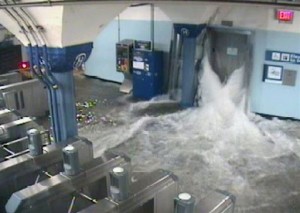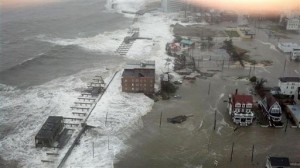Innovative coverage of superstorm Sandy
October 30, 2012
First of all, we hope you are safe and that your loved ones are safe. Our thoughts and prayers go out to everyone affected by Hurricane / Superstorm Sandy.

A PATH station in Hoboken, N.J. flooded in the storm surge of Hurricane Sandy on Monday, Oct. 29, 2012. (AP Photo/Port Authority of New York and New Jersey)
Natural disasters bring out many of the cliches of traditional media (reporters standing in the middle of a storm surge, photos of empty store shelves, and so on). But they also bring out some of the best and most useful work journalists perform for the public: keeping people informed about what’s happening in real time, helping them find local assistance, identifying dangerous areas to avoid, and telling those who aren’t in harm’s way how they can help.
With that in mind, we’ve been looking for the most innovative digital coverage of Hurricane Sandy. Here’s what we’ve found so far. Found something else? Post a comment below.
Local Resources and Grass Roots Media
- Jersey Shore Hurricane News: Operating completely on Facebook, this “bottom-up, two-way news outlet” is posting photos, videos and critically important aid information to people on the New Jersey coastline and many others who are looking for ways to help. It’s also serving as a community hub for people who are looking for missing people and lost pets. The site launched after Hurricane Irene in 2011 with 27,00 followers, and is already up to over 140,000.
- MTA on Flickr: The Metropolitan Transportation Authority that’s responsible for the New York subways and buses is posting photos of the transportation damage on its Flickr feed.
- The Hurricane Hackers group, a project of the MIT Media Lab that software programmers and data geeks are using to create new tools to assist during the aftermath of the storm.
- CNN iReport Sandy Damage Open Story: CNN-curated user videos of hurricane damage zones. Every video shows its location on a map to the side, and you can navigate through the map to find videos of specific areas. Users can also upload to the page, or from the iReport app.
Maps and Mapping APIs
- New York Times’ Power Outage Map: Shows power outages in and around New York City, with time graphs showing how many customers are without power. Updated every 15 minutes.
- The Guardian’s Sandy Map: The Guardian’s Data Blog is tracking and mapping verifiable events in Sandy’s aftermath. Every event includes a link to more info, and the ability to download full data as a Google Fusion table. (Thanks to our friends at the Center for Innovation in College Media for sharing this).
- Google’s Hurricane
#Sandy map showed the most recent hurricane cone prediction as it approached land, but also has other information layers — such as storm surge probability.
Live Coverage, Curation and Aggregation
- DigitalFirst Media’s Hurricane Sandy News: This topical aggregation page was going all day and night featuring the latest news from affected areas. It took wire reports, local reports, and combined them into one site.
- New York Times’ Sandy Webcam: The New York Times put a webcam on top of its roof and posted an updated picture every minute — now compiled into an animation. It provides a time-lapsed view of the storm over three days.
- Buffy’s World: Buffy Andrews of the York Record created several interesting and well-done slideshows on her blog using photos found via social media.
Data Visualization and Infographics
- Hint.fm’s Wind Map: A beautiful visualization of surface wind data from the National Digital Forecast Database, revised once per hour. Note that while the map uses real data, it should not be used for navigation, flight planning or anything mission-critical.
- New York Times Infographics: The Times also posted some good interactive infographics the morning after the storm.
- WNYC Flood Gauge: WNYC in New York had a real-time flood gauge, allowing people to see exactly how high the New York City rivers were in real time.
Creative Use of APIs, Data

The Inlet section of Atlantic City, N.J. is flooded as Hurricane Sandy makes it approach on Monday Oct. 29, 2012. (AP Photo/6abc Action News, Dann Cuellar.
- Instacane: Instagram is growing in popularity as a news source in breaking news, as people are using it to share and post photos they take (rather than Flickr, Facebook or Twitter). This app allows users to create galleries of Instagram photos.
- The IRE News blog has a great post about how data journalists spread information about the storm.
- NJ.com #NJopen Twitter Feed: Sometimes the best innovations are also the simplest. NJ.com is using the Twitter API to pull in live tweets hashtagged #njopen and #njgas so residents can quickly find out where to get food, and where to get gas.
Fact Checking
- Poynter’s Fake Photo Tips: There were plenty of photos posted yesterday that were fakes, either new or recycled from other disasters. Poynter provided some good tips on how to spot a fake.
- The Atlantic also did its best to fact-check them and clearly label the fakes.
Noteworthy New Tools
- SeeClickFix: This app for iOS and Android lets you post problems that need to be fixed. The startup made its platform available for free to any media in hurricane affected areas to create widgets.
All photos on the main page linking to this post are courtesy of the Associated Press.
– Dan Pacheco & Brian Moritz.
Professor Pacheco in the Press
Corazón del Barrio captures the importance of community engagement
Comments:
- Newhouse professor Daniel Pacheco and students from his virtual reality class visited La Casita Sept. 8 to film and photograph a group of dancers, led by Luz Encarnación. After a few hours, the students had taped enough footage to create a 3D virtual reality video...
CNN: Some of the most iconic 9/11 news coverage is lost. Blame Adobe Flash
Comments:
- Dan Pacheco, professor of practice and chair of journalism innovation at Syracuse University's Newhouse School, has experienced the issue firsthand. As an online producer for the Post's website in the late 1990s and later for America Online, some of the work he helped build has disappeared...
How Microsoft's HoloLens 2 is bringing augmented reality to your job
Comments:
- “I think we will be seeing two camps: Microsoft and a few startups like Meta2 and Vuzix on the business end, and Magic Leap and Apple (when Apple releases its rumored glasses) on the consumer end,” Dan Pacheco, a professor of journalism and chair in journalism innovation at Syracuse University’s S...
Digiday: Despite limitations, publishers plot more augmented reality for 2019
Tags: no_tag
by: Dan Pacheco
5 Axes of Convergence that are Transforming the PR Industry - Nasdaq.com
Tags: no_tag
by: Dan Pacheco
The future of news: Professionals, students come to Newhouse for innovative drone journalism training | Newhouse School - Syracuse University
Tags: no_tag
by: Dan Pacheco
Dan Pacheco to Discuss ‘VR in Journalism’ at Virtual Reality Summit in Seoul June 28-29 | Virtual Reality Summit
Tags: no_tag
by: Dan Pacheco
An SU student startup uses virtual reality to read the news | The Daily Orange – The Independent Student Newspaper of Syracuse, New York
Tags: no_tag
by: Dan Pacheco
360° videos and VR: immersive journalism is here to stay? – – International Journalism Festival
Comments:
- Video of Dan Pacheco's panel on VR and 360 video for journalism at the 2017 International Journalism Festival in Perugia, Italy. - Dan Pacheco
Tags:
Tags: no_tag by: Dan Pachecottps://medium.com/google-news-lab/announcing-the-google-news-lab-university-network-d1772a5bc007 - Google Search
Pizza, virtual reality and ethics intersect at Sundance Ignite On Tour | The Daily Orange – The Independent Student Newspaper of Syracuse, New York
Tags: no_tag
by: Dan Pacheco
Become a tree at this year’s Sundance Ignite On Tour | The Daily Orange – The Independent Student Newspaper of Syracuse, New York
Tags: no_tag
by: Dan Pacheco
Newhouse School to host drone journalism seminar | The Daily Orange – The Independent Student Newspaper of Syracuse, New York
Tags: no_tag
by: Dan Pacheco
2016 Mirror Awards Ceremony - YouTube
Comments:
- Nonny de la Peña had this to say about Professor Pacheco after her acceptance of an I-3 Mirror Award.
“Once the [Oculus] Facebook sale happened, $2 billion dollars, you’re not so nuts. But before that happened, a lot of people thought trying to do journalism in virtual reality was crazy...
Students, Faculty to Create Content for HoloLens Augmented Reality Headset
Comments:
- Prof. Dan Pacheco has been accepted into the HoloLens developer program and will work with Newhouse students and faculty to create content for the device. - Dan Pacheco
Tags:
Comments:Immersive journalism: What virtual reality means for the future of storytelling and empathy-casting - TechRepublic
http://storynext.gannett.com/state-of-vr.pdf
Comments:
- Prof. Pacheco co-authored the primer on virtual reality in this report on The State of Virtual Reality in Journalism for Gannett and the Knight Foundation. - Dan Pacheco
